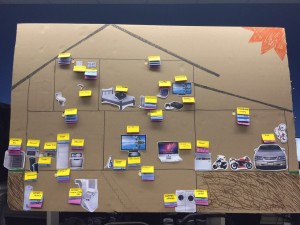Hello! Since we have currently just finished our first prototype using cardboard and paper (applause), I would like to talk about the road to creating our paper prototype, the “Energy Lab House”.
Design Pillars
We began our design process by specifying the objective of the game. We identified 4 main goals that would guide us in our brainstorming process:
- Encourage change in habits to lower energy usage
- Get kids excited about science
- Synthesize solar, wind and fossil fuels
- JUST BUILD IT!
Iteration #1
By following these guidelines we came up with several ideas to be discussed with one another. Based on these ideas, we identified several core ideas that felt appropriate and decided to incorporate these ideas into the prototype.
- Exciting to feel the difficulties of producing energy by simulating the creation of energy through a physical activity such as a crank
- Fun to compare different energy consuming appliances and guess the higher consuming one
- Preference to knowledge based game that may lead to eventual habit changes rather than focusing on habit changes
- Showing how an amount of coal or fossil fuel translates to a tangible amount that would be understood by the students. For example, showing that 2 trucks of coal would translate to 100 cups full of water which powers a light bulb for a year.
- Saving and managing money over a period of 10 years to teach the importance of energy conservation
- Understanding the high energy consumption areas at home
- Learning the importance of changing habits
- Learning the affordability of alternative energy sources
We designed a simulation game that challenges the player to reduce energy consumption in a energy consuming house. They have to identify energy consuming appliances and change habits in order to reduce energy consumption at home. Their ultimate goal is to save as much money as possible.

First iteration of paper prototype.
In the first iteration, we created a cardboard house with the following objects on it:
- Cut outs of printed appliances and things that consume energy in the house
- Yellow labels identify what each item is
- Blue labels represent an upgrade to the appliance and its upgrade cost
- Purple labels represent a habit change
- Blue and Purple labels have a savings amount that is hidden from the player
Players have printed physical money which will be used to pay energy bills. Energy consumption is also simulated with an energy meter that decreases based on energy usage at home. Players have to use a crank which is required to fill up the energy meter just before it empties. This mechanic allows the player to feel the burden of generating energy.

Printed money and crank being used by the player.
Rules:
- This is a single player game
- Player has 5 turns in this game. Each turn represent a year which determines the energy bill of the house after each year.
- Each turn lasts for 60 seconds.
- $500 is a yearly income for the player.
- Energy meter has to be cranked to the maximum amount at the start.
- Player looks at all appliance in the house.
- Player uses the $500 to upgrade appliances at home. Player learns how much is saved from upgrading the appliance.
- Player makes 2 habit changes. Player learns how much is saved from making the habit changes.
- Player cranks the energy back to full if the energy meter is too low.
- Player ends the turn once the time is up.
- Player is given the amount of money that has been saved for the turn.
- Player is given $500 again at the start of a new turn.
- The turn continues again from Step 5 until the end of turn 5.
- Player is told how much is saved. The amount saved is the score achieved by the player.
- Player can use this score to compare how they fare compared to other players.
Observations:
- Player receive money every turn and it is easy to purchase all the upgrades. No considerations are required.
- Player has to crank at the same time which is frustrating. Player is unable to focus on cranking and finding energy consumption areas at the same time.
- Player finds that there is no time to read all the habit changes.
- Player has to fumble through physical money every turn to pay the bills. Although it feels good to hold on to money, it seems to be a time consuming task.
- Player finds it satisfying to learn that he has made a positive impact
Iteration #2
Based on the problems identified above, we decided to employ the following solutions:
- Player receive only $500 at the first turn
- Crank and energy depletion mechanic is removed.
- Player is given 90 seconds
- The money saved or spent is read aloud to the player
Updated rules:
3. Each turn lasts for 60 seconds. Each turn lasts for 90 seconds.
4. $500 is a yearly income for the player. Player is given $500 at the start of the turn.
5. Energy meter has to be cranked to the maximum amount at the start.
9. Player cranks the energy back to full if the energy meter is too low
12. Player is given $500 again at the start of a new turn. Player uses the left over money and his savings for this turn to start the next turn.
16. Player is told how much $500 has been converted into their end result at the end of 15 years
Observations:
- Player find it too easy as most upgrades yield a positive saving
- Player remember the upgrade that costs a lot yet saves nothing, ie Trash Compactor
- Player remember the upgrade that saves a lot of money, ie Car
- Player is surprised by how little energy some appliance use
- Player do not have to think much about choosing a habit since all if it is a positive action
- Player felt proud to learn that they have converted $500 to a 5-figure sum at the end of 15 years
Conclusion
With the latest play test at Elizabeth Forward, we understood that students were able to learn about energy consumption through this game. The different appliances had different impacts on them based on how much was saved or lost. The items in the house that has the most impact were those that had the largest contrasting difference to cost and savings ratio. However, we have to design the game to increase the impact made by the other appliances at home. Apart from that, from this prototype, we have yet to include our 3rd design pillar of synthesizing other energy resources. Despite that, we believe that we have obtained substantial information from our first prototype and we will be moving on to the next phase of development. We will begin development on the digital prototype. For the digital prototype, we would like to test the following:
- Add other risky upgrades and habits that may cause more money than savings. This will hopefully force the player to think about each decision they make.
- Consider adding new upgrades after a set number of turns. Renewable energy sources such as solar panels may be added as an optional upgrade.
- Subsequent habit changes. A habit change may lead to more habit changes that save more money.